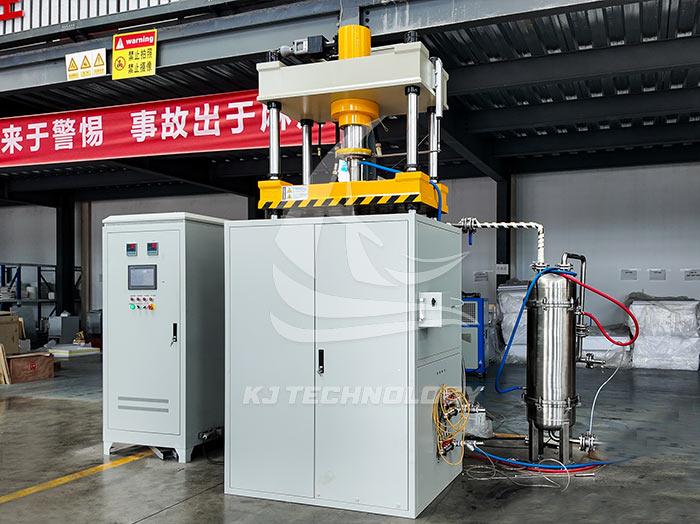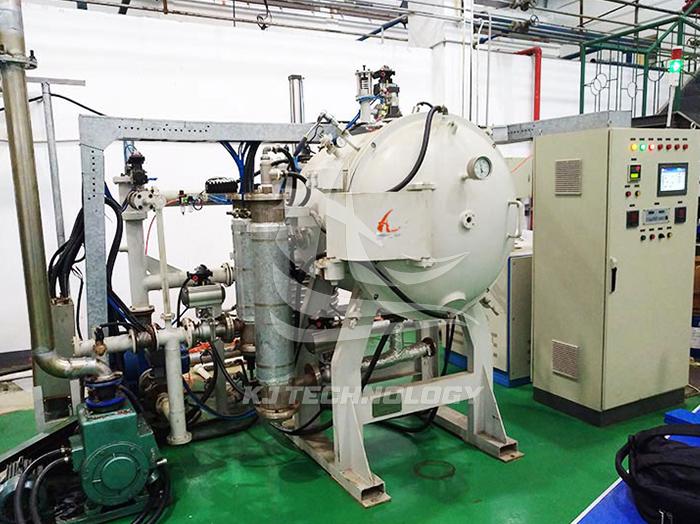What are the temperatures of vacuum hot pressing furnaces used in experiments?
 09-22-2025 Author: KJ technology
09-22-2025 Author: KJ technology
The temperature range of the experimental vacuum hot press furnace varies depending on the equipment design, heating element type, and target material, usually covering the low to ultra-high temperature range to meet the sintering, synthesis, or heat treatment needs of different materials. The following is a detailed classification of its temperature range and typical application scenarios:
1. Conventional temperature range
The basic temperature range for experimental vacuum hot pressing furnaces is usually from room temperature to 1600 ℃, which is suitable for hot pressing preparation of most metals, ceramics, and composite materials.
Low temperature range (from room temperature to 600 ℃)
Application Scenario:
Remove volatile components (such as molding agents and moisture) from the material.
Pre sintering of metal powders (such as initial densification of copper powder and iron powder).
Example:
When preparing WC Co hard alloy, keep it at 300-500 ℃ for 1 hour to completely evaporate the paraffin forming agent.
Medium temperature range (600 ℃ to 1200 ℃)
Application Scenario:
Low temperature bonding between metals and ceramics (such as diffusion bonding between Al ₂ O ∝ ceramics and Kovar alloys).
Preliminary sintering of oxide ceramics (such as densification of Al ₂ O ∝ and ZrO ₂).
Example:
When sintering alumina ceramics, hold at 1000 ℃ for 2 hours to form neck bonds between particles.
High temperature range (1200 ℃ to 1600 ℃)
Application Scenario:
High temperature sintering of hard alloys and metal ceramics (such as WC Co, Ti (C, N) - Ni based alloys).
Densification of non oxide ceramics (such as Si ∝ N ₄ SiC)。
Example:
When preparing silicon nitride ceramics, a pressure of 30 MPa is applied at 1500 ℃, and densification is achieved through liquid-phase sintering.
2. High temperature expansion range
Some high-end experimental vacuum hot pressing furnaces can increase the temperature to 1600 ℃ to 2200 ℃ by optimizing the heating elements and insulation materials, meeting the requirements for the preparation of ultra-high temperature materials.
1600 ℃ to 1800 ℃
Application Scenario:
Sintering of superhard materials such as diamond/cubic boron nitride composites.
The synthesis of high melting point intermetallic compounds (such as Ni ∝ Al, TiAl).
Example:
When sintering Ti (C, N) - Ni metal ceramics, applying a pressure of 20 MPa at 1700 ℃ promotes the infiltration of liquid Ni into Ti (C, N) particles.
1800 ℃ to 2200 ℃
Application Scenario:
Densification of refractory metals (such as W, Mo, Ta) and their alloys.
Ultra high temperature sintering of advanced ceramics such as ZrB ₂ and HfB ₂.
Example:
When preparing tungsten copper composite materials, apply a pressure of 50 MPa at 2000 ℃ to allow liquid copper to infiltrate the tungsten skeleton.
3.Special temperature control technology
To meet the complex process requirements, experimental vacuum hot pressing furnaces are often equipped with the following temperature control technologies:
Multi zone independent temperature control
Principle: Divide the furnace chamber into three zones (or more zones): upper, middle, and lower, and set independent temperature curves for each zone.
Application:
Compensate for temperature gradients inside the furnace (such as avoiding overheating at the top or undercooling at the bottom).
Realize the preparation of gradient materials (such as functionally graded thermal barrier coatings).
Example:
When sintering samples with a large aspect ratio, the top temperature is 10-20 ℃ higher than the bottom to offset heat loss.
Rapid heating/cooling
Principle: High power heating elements (such as graphite induction heating) and efficient cooling systems (such as air-cooled+water-cooled composite cooling) are used.
Application:
Inhibit grain growth (such as sintering of nanoceramics).
Shorten the process cycle (e.g. total time from heating to cooling<5 hours).
Example:
When sintering nano TiO ₂ ceramics, heat up to 800 ℃ at a rate of 20 ℃/min, hold for 30 minutes, and then quickly cool to room temperature.
Ultra high temperature pulse heating
4. Temperature selection criteria
The temperature setting of the experimental vacuum hot press furnace should comprehensively consider the following factors:
Melting point and phase transition temperature of materials
The temperature should be lower than the volatilization temperature of the material (for example, the melting point of Co in WC Co is 1495 ℃, and the sintering temperature is usually ≤ 1450 ℃).
Avoid harmful phase transitions at high temperatures (such as Al ₂ O ∝ potentially decomposing into Al and O ₂ above 1600 ℃).
Adhesive phase activity
Metal bonding phases (such as Co, Ni) need to infiltrate ceramic particles in a liquid phase state (such as the Co phase in WC Co melting above 1300 ℃).
The temperature should be higher than the melting point of the bonding phase but lower than the decomposition temperature of the ceramic.
Equipment limits and safety
The temperature should not exceed the oxidation resistance limit of the heating element (such as graphite) (graphite begins to oxidize at 400 ℃ in air and can withstand 2200 ℃ under vacuum).
Safety margin needs to be reserved (such as equipment rated temperature of 2200 ℃, actual use ≤ 2100 ℃).








